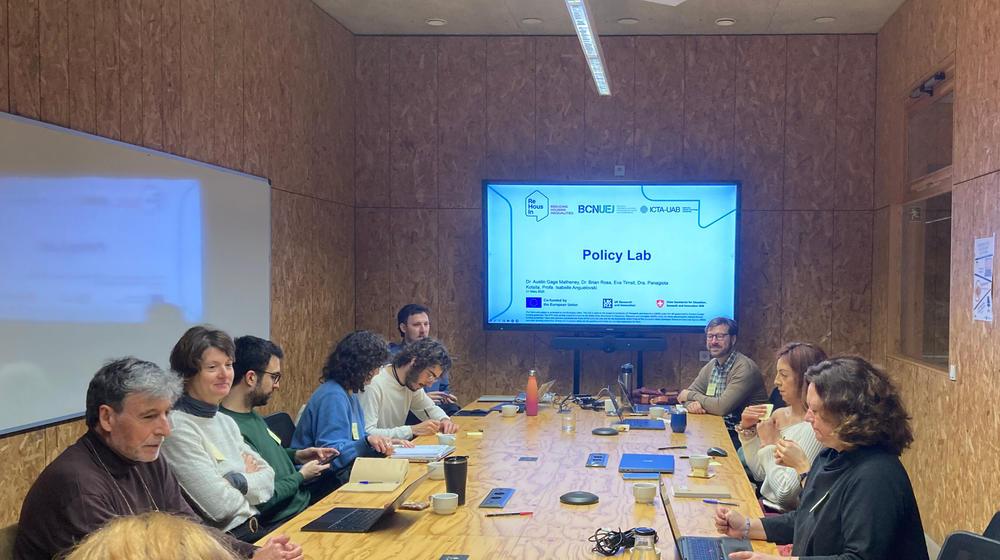ReHousIn Policy Lab in Spain: Exploring new pathways for fair and sustainable housing

On 21 March 2025, the Universitat Autònoma de Barcelona hosted their first ReHousIn Policy Lab, a dynamic event that brought together experts, public officials, and housing sector stakeholders to co-create policy solutions at the intersection of the housing crisis and the ecological transition.
Held in the ICTA-ICP building on the UAB campus, the lab provided a collaborative space to rethink how Spanish cities can tackle issues of housing accessibility, energy-efficient rehabilitation, and urban green planning. These discussions are critical, as they respond to two converging challenges – affordable housing and environmental sustainability – through a unified policy lens.
The Policy Lab brought together representatives from a range of institutions, including regional and municipal housing agencies, government departments, research institutes, and urban planning consultancies. Participating organisations included the Plan Estratégico Metropolitano de Barcelona (PEMB), the Generalitat de Catalunya (RIS3CAT), NASUVINSA (Navarra’s public housing and land agency), the Ministry of Housing, the Institute of Human Rights and Business, Celobert (technical support for rehabilitation projects), INCASOL (Catalonia’s public housing agency), the Municipal Housing Institute of Barcelona, and IDRA – Urban Research Institute of Barcelona, among others.
From policy to practice: what was discussed
The lab was structured around three core themes:
- Access to housing and the challenges of energy rehabilitation
- Environmental policies and nature-based solutions in housing and urbanism
- Governance, policy alignment, and residential densification
Participants were split into small groups, joined by at least one researcher from the ReHousIn project, to discuss the complex tensions between ecological goals and social equity through the lens of each core theme.
Making retrofit fair: Bridging the gap between policy and practice
During discussions around the first theme – access to housing and energy-efficient rehabilitation – participants highlighted a major disconnect in current retrofit policies: while most funding and incentives are directed toward private homeowners, it's often renters who live in the most inefficient, poorly maintained buildings. As one attendee put it, “Most incentives go to owner-occupiers; but tenants are often the ones most in need of improvements.”
This raised important questions about how to ensure that energy retrofits do not deepen existing inequalities. Participants emphasised the need to simplify application processes, support collective building-level action, and put safeguards in place to protect tenants from rent hikes or displacement following upgrades. The group agreed that without stronger tenant protections and more inclusive mechanisms, retrofitting risks becoming a driver of exclusion rather than equity.
Green doesn’t always mean fair
Addressing the second theme, discussions revolved around the dual nature of green infrastructure: while it improves urban liveability, it can also fuel gentrification. The example of Cristóbal de Moura – a green corridor in Barcelona’s 22@ district – was raised, where private developers funded public space upgrades. As one participant pointed out, “these investments improve neighbourhoods, but who captures the value? Often, it’s not the original residents.” A call was made to design policies that capture real estate value increases for public benefit, and to prioritize community-managed green spaces that are less susceptible to speculative pressure.
Densification through a human lens
When discussing the third core theme, the conversation focused on optimising urban land use without expanding into natural or agricultural areas. Participants explored the concept of “soft densification” – subdividing large under-occupied flats, building rooftop additions (“remuntas”), and the tensions arising through a new aim to convert ground-floor commercial spaces into housing. A key question was raised when discussing ‘densification’ in the Spanish context – as one participant highlighted, ‘increasing housing density is perhaps not as important as the density of people’, noting that our conceptualisations of these key terms need to be geographically sensitive. Many stressed that these strategies must go together with social dialogue and neighbourhood-scale planning to avoid disrupting existing communities.
A few standout ideas from the event:
It is of vital importance to strengthen tenant rights in renovation and retrofit processes, to avoid tenants either not being able to access such improvements or being displaced as a consequence of their implementation.
It is critical to design inclusive, community-managed green spaces, which prioritise everyday use by local residents and reduce the risk of gentrification often associated with high-end or top-down greening initiatives.
Soft densification should be promoted through strategies like rooftop extensions, subdividing oversized flats, or converting underused buildings – allowing for more housing within the existing urban footprint, while preserving neighbourhood character.
It is worth considering repurposing vacant ground-floor commercial spaces for housing, especially in areas with long-term retail vacancy, to create affordable units and reinvigorate street-level life without expanding the built environment.
Community engagement before introducing social housing is a prerequisite for success, as it fosters local understanding, addresses concerns, and builds social cohesion, particularly in neighbourhoods where resistance to subsidised housing remains strong.
As one participant put it:
“We need to stop thinking of climate and housing policy as separate – they’re deeply interconnected. And if we don't design for both, we’ll fail at both.”
Publishing date: